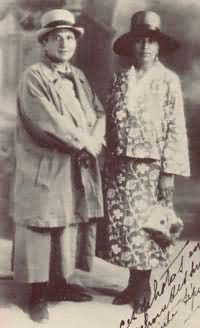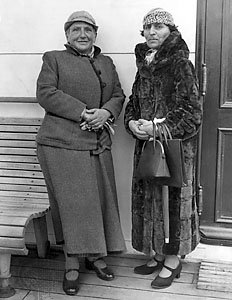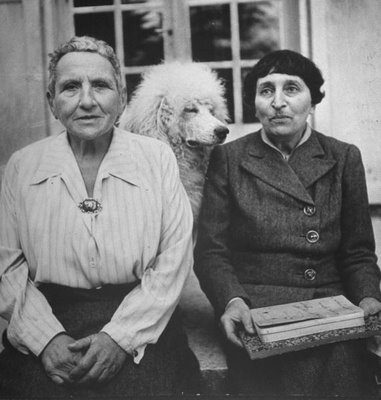October 24, 2016 - 18:13

We will meet for an hour today, beginning @ 12:55 in Thomas (not Taylor) 104.
Jody's class will meet immediately thereafter in the same room, 1:55-2:55.
I. coursekeeping
* reactions to our conversation S-LParks on Thursday afternoon?
(what questions/responses did you not voice then...? why not...?)
* By midnight tonight: short posting #3, reflecting on
how that conversation w/ S-LParks altered your understanding
of her work; or on the practice of close reading GM'sB or TBoS--
esp interested of course in what/how you'd like to focus our reading
of this new novel
* class is cancelled on Thursday; we will meet @ Pem Arch @ 2:55 p.m.
for our 3:00 p.m. field trip to Norris Square;
weather will be miserable (cold and wet); dress appropriately!
* show you a 10-minute video @ the end of class,
abt the women who founded the garden 40 yrs ago;
our tour will be led the h.s. students who intern there now
* prepare for the trip by reviewing the information @ their website @
http://www.myneighborhoodproject.org/site/
* Franny, Jodi, Nyasa: watch the 30-min version of this video,
plus another 15-min one on the same DVD; then do a posting
about what you learned/your reactions...I'll need the video
back by next Tuesday
* for next Tuesday's class: middle 1/3 of
The Book of Salt, through Chapter 16, p. 175.
II. Beginning The Book of Salt
* by attending to the language--still pursuing/pushing this concept of close reading
* such mixed feelings (part of the South I've been trying to leave behind:
the attention to surfaces :)
* this course structured around the concept of "revising racial fictions":
w/out time to read all the earlier texts, inviting you to think about
all the texts lying behind Lemonade,
slave narratives ->Beloved,
native narratives->The Truth About Stories,
Jimmy Baldwin -> Getting Mother's Body,
and now! Gertrude Stein -> The Book of Salt
anyone know any of her work/reputation?
just a taste of this, as background/framing/
invitation to read Truong's novel more carefully
Kiss my lips. She did.
Kiss my lips again she did.
Kiss my lips over and over and over again she did.
I have feathers.
Gentle fishes.
Do you think about apricots. We find them very beautiful. It is not alone their color it is their seeds that charm us. We find it a change.
Lifting belly is so strange.
I came to speak about it.
Selected raisins well their grapes grapes are good.
Change your name.
Question and garden.
It's raining. Don't speak about it.
My baby is a dumpling. I want to tell her something. Wax candles. We have bought a great many wax candles. Some are decorated. They have not been lighted.
I do not mention roses.
Exactly.
Actually.
Question and butter.
I find the butter very good.
Lifting belly is so kind.
Lifting belly fattily.
Doesn't that astonish you.
You did want me.
Say it again.
Strawberry.
Lifting beside belly.
Lifting lindly belly.
Sing to me I say.
Some are wives not heroes.
Lifting belly merely.
Sing to me I say.
Lifting belly. A reflection.
Lifting belly adjoibs more prizes.
Fit to be.
I have fit on a hat.
Have you.
What did you say to excuse me. Difficult paper and scattered.
Lifting belly is so kind.
what is going on here?? how does this poem "work"?
"Steinian texts produce in all readers bewilderment...."
Elizabeth Fifer, "Is Flesh Avisable? The Interior Theater of Gertrude Stein, Signs, 4, 3 (Spring 1979): 472-283.
Penelope Engelbrecht, "'Lifting Belly is a Language': The Postmodern Lesbian Subject," Feminist Studies, 16, 1 (Spring 1990): 85-114.
Susan Holbrook, "Lifting Bellies, Filling Petunias, and Making Meanings through the Trans-Poetic." American Literature, 71, 4 (December 1999): 751-771.
--oddly contradictory critical responses: erotic, "explicit"...also veiled or coded
--decoding seems to miss the mark: the one-to-one equivalence that encryption presumes would deny the polysemnic, indeterminate trajectories of Stein's vocabulary
--the word can be erotic on two opposing conditions, both excessive: if it is extravagantly repeated, or on the contrary, if it is unexpected, succulent in its newness
--"insistence" draws our attention to the material of language, which is generally rendered a silent ferry to the signified....iteration invites us to engage sound and shape in a more intimate way--to enjoy close reading.
--[from "A Transatlantic Interview 1946:] "You had to recognize words had lost their value in the Nineteenth Century...they had lost much of their variety, and I felt that I could not go on, that I had to recapture the value of the individual word, find out what it meant and act within it."
--Stein's poetic interrogates the very surveillance of visibility....Error offers the promise of freedom in a language that would correct deviance, a language that...offered very little in the way of a lexicon for lesbian partnership
--the meanings produced are variable, multiple, and provisional....What drives this persistent variability is a radically paradoxical representational stance....Stein...repeatedly overturns moments of clear referentiality
--only by a sort of indirect treatment...we can hope to grasp the object...because as soon as we name it...our sense of a vital particularity is eclipsed in the generic blankness of the noun...
--nouns are redeemable...in the context of poetry...in the genre that "is doing nothing but using losing refusing and pleasing and betraying and caressing nouns....that is poetry really loving the name of anything and that is not prose."
Stein's ambivalence about naming resonants with more contemporary concerns about the limitations of identity politics...the simultaneous exigency and liability of naming abjected sexuality. If a taxonomy is felt to be crucial for gays and lesbians as a means to facilitate community building and identification, it can certainly also serve the interests of state control, easing the regulatory mechanisms of, for example, homophobic legislation and medical pathologization.
--"Can sexuality even remain sexuality once it submits to a criterion of transparency and disclosure, or does it perhaps cease to be sexuality precisely when the semblance of full explicitness is achieved?....I would like to have it permanently unclear what precisely that sign [the word lesbian] signifies....[to establish] the instability of the very category that it constitutes." (Judith Butler, "Imitation and Gender Insubordination," in The Lesbian and Gay Studies Reader, 1993)
III. the background to Truong's novel is profound modernist (political) experimentation;
sets the stage for our watching Bình master the art of interpretation (beyond words):
"My comprehension...is based mostly on my ability to look for the signals and intepret the signs. Words...are a handy shortcut to meaning. But too often, words limit and deny" (117).
"there is no narrative...in good sex. There is no beginning and there is no end, just the rub, the sting, the tickle, the white light of the here and now" (63).
"Pointless overdecoration, GertrudeStein explains, thinking of the commas and periods she has plucked from the pages of her writings. Such interference, she insists, are nothing more than toads flattened on a country road, careless and unsightly. The modern world is without limits, she tells Miss Toklas, so the modern story must accomodate the possibilities--a road where she can get lost if she so choses or go slow and touch each blade of grass." (The Book of Salt, 28)
"Stein's poetic...repeatedly overturns moments of clear referentiality..."
"What if language need not be mimetic?"...if "language has no discernible mimetic meaning"?
"Literature is that which denounces and slashes apart the repressing machine at the level of the signified" (from Kathy Acker's "Seeing Gender").
REALLY: CAN words be non-referential? Can they NOT signify? Will/won't they always?
Might the answers to these questions be class-, or race-, or gender-, or geographically-specific?
Similar questions re: abstract art/images that do/n't attempt to represent "the real"
Truong uses images a LOT to anchor/expand/explode the meaning of her/Bình's words...
For example, on p. 36, GertrudeStein asks,
"Thin Bin, how would you define 'love'?"...a classic move from the material to the spiritual...
I point to a table on which several quinces sit yellowing in a blue and white china bowl.
I shake my head in their direction, and I leave the room, speechless....

[on p. 40, he gives us (if not her) his answer:]
"Quinces are ripe...when they are the yellow of canary wings in midflight....But even then quinces remain a fruit, hard and obstinate...until they are simmered, coddled for hours above a low, steady flame....a color you can taste...love is not a bowl of quinces yellowing in a blue and white china bowl, seen but untouched."
Many other images are evoked and minutely described in the text:

"I am ... enthralled by her upper lip with its black hairs twitching gently as she speaks. Her moustache, I think, would be the envy of all three of my brothers, who could only aspire to such definition after weeks' worth of unfettered growth. The arc of hair, like a descended third eyebrow, is topped by a solemn monument to the god of smells. Protruding from her forehead, abruptly billowing out as it reaches her eye sockets, it is not so much a nose as an alterpiece that segregates the left side of her face from her right. Moving northward, her facial features disappear underneath a skullcap of hair, dark, absorbing the late-afternoon light. I am overwhelmed by the intrusiveness of it all until I look into her eyes. They live apart from their housing. Chasing the light that gilds this city in early autumn, her irides are two nets gently swooping over a band of butterflies. Catching the light, the circles erupt, bright with movement, the flapping and fanning of many colored wings" (25).
How would you characterize his description of Miss Toklas?
IV. The novel relies heavily on photographs to open and end:
"Of that day I have two photographs and, of course, my memories...." (1)
"GertrudeStein, unflappable, unrepentant, unbowed, starts back at me and smiles. This photograph of her and Miss Toklas, the second of two that I have of that day, was taken on the deck of the SS Champlain. It captures my Mesdames perfectly. I am over there, the one with my back turned to the camera ... alongside the photograph taken at the Gare du Nord ... I am partial to the one of them at the train station.
GertrudeStein and Miss Toklas are perched on the bench ahead of me. My Madame and Madame are posing for a small group of photographers who have gathered for the occasion. GertrudeSein looks almost girlish. The folds of a smile are tucked into her ample cheeks. Miss Toklas looks pleased but as always somewhat irritated, an an oyster with sand in its lips, a woman whose corset bites into her hips...."





![]()
![]()
V. next week, discussion guided by your postings...
also want look harder/longer at the uneasy power relations in the novel,
@ how gender intersects with varieties of racialized class formation,
--distorted intimacies of domestic service as a microcosm of distorted geopolitical relations
--condescension and racism in unwillingness to learn how to pronounce Bình's name correctly
VI. By 1:45: 10-minute video of Norris Square's African garden...
